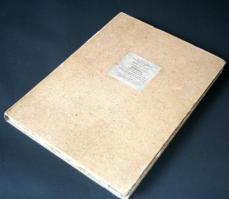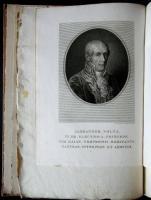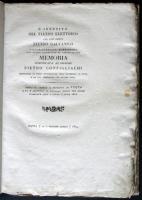www.gauntantik.com
VOLTA, Alessandro; [CONFIGLIACHI, Pietro]
L'Identità del Fluido Elettrico col cosí detto Fluido Galvanico vittoriosamente dimostrata con nuove esperienze ed osservazioni: Memoria Comunicata al Signore Pietro Configliachi
Pavia: G. Giovanni Capelli, 1814
First edition. Quarto, overall 33.5 x 24.8 cm, the pages 33 x 24 cm (variable). Engraved portrait of Volta by Giovita Garavaglia, vi, [2], 145, VII pages. Rose-speckled beige paste paper covered boards (possibly later 19th c.) with engraved title-pieces on spine and front cover, cream wove endpapers, uncut and unopened. Collates [π]4, 14-194, frontispiece engraving following [π]1: [1l.] (blank), 1l. (title recto), 1 l. (portrait of Volta verso, with serpent), pp. iii-vi (“Alli Signori Studenti”), 1l. (fly-title recto, Newton quotation verso), pp. [1] – 144 (VII Articuli, Conclusione), 145 (Indice), I – VII (Catalogo Delle Opere Stampate) (Acciunta slip tipped to VII), [1l.] (blank). Printed letterpress on cream moldmade laid paper with foolscap (?) watermark. Overall very good, near fine internally (unopened throughout), backstrip rubbed and faded, a portion reattached, moderate edgewear, lower tips worn through, repaired closed tear on front free blank, minor staining on title and last page, minor marginal soiling, an exceptional copy, the unopened text block tight and square and generally unblemished.
Volta’s researches and experiments during his long-running contention with Luigi Galvani over the source of the galvanic excitations causing spasms in animal tissue led to the publication of the “Voltaic pile” in 1800, forerunner of all primary batteries. Volta had hypothesized that the electricity arose from impurities in “moist conductors” between pairs of metal conductors, rather than from “animal power” as claimed by the Galvanists. The invention of the pile captured the imagination of Napoleon, who authorized the Académie des sciences to award a medal "for the best experiment made each year on the galvanic fluid" and a prize of 60,000 francs "to whoever by his experiments and discoveries makes a contribution to electricity and galvanism comparable to Franklin's and Volta's" (DSB XIV, 79, quoting Opere II, 122). Humphry Davy, who called the Voltaic battery "an alarm-bell to experimenters in every part of Europe” (W.H. Brock, 1992, p. 147), soon applied it to electrolyze the alkali metals, a discovery for which he was awarded Napoleon’s “Prix de l’Institut” in 1808 and which presaged the laws of Oersted, Ohm, and Faraday (DSB XIV, 80).
In all this Volta was content to devote his efforts toward refuting the old doctrine of animal electricity, still very much alive. Authoring a lengthy review of his reasons for identifying galvanic and common electricity, he submitted it under the name of a student in a prize competition announced in 1805 by the Societàltaliana delle Scienze as follows: "Explain with clarity and dignity, and without offending anyone, the question of galvanism disputed by our worthy members Giovanni Aldini and Alessandro Volta" (DSBXIV, 80, quoting Opere II, 206). This review of Volta’s researches and experiments leading to victory over the Galvanists and culminating with the Voltaic pile was printed in 1814 as Memoria Comunicata al Signore Pietro Configliachi, his student and successor (DSBXIV, 80, quoting Opere II, 205-207). Fourteen years removed from his great triumph, this last memoir is nevertheless the first edition of the seminal researches and experiments that caused Napoleon to rank Volta’s name with Franklin’s.
Catalogue of the Wheeler Gift, Library of the American Institute of Electrical Engineers (1909), no. 726, p. 272
Dictionary of Scientific Biography, J.L. Heilbron, “Volta, Alessandro Giuseppe Antonio Anastasio,” XIV, pp. 69-82 (quoting Le Opere, 7 v., Milan, 1918-1929)


